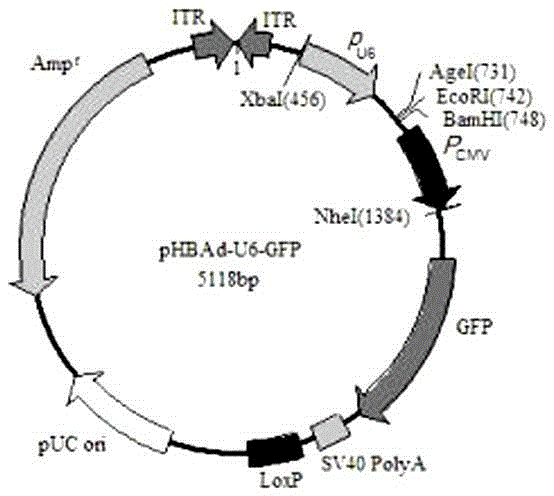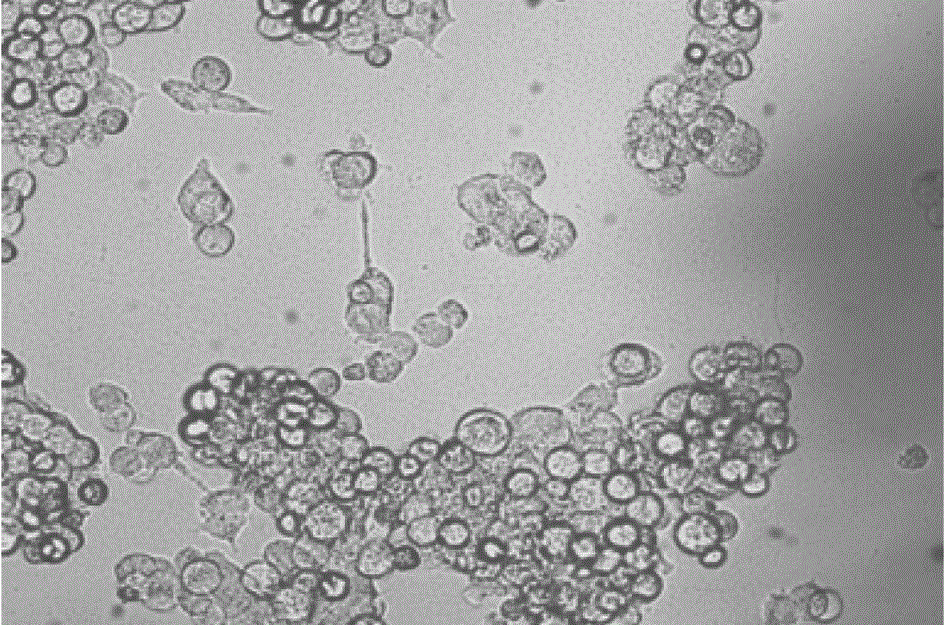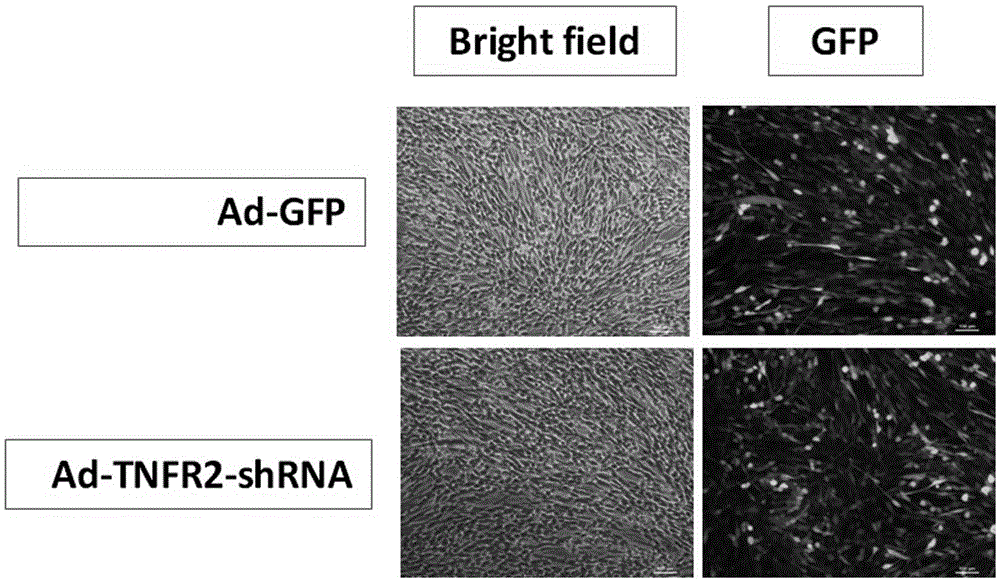Recombined Ad-TNFR2 shRNA adenoviridae and construction and application thereof
A technology of adenovirus and construction method, applied in application, virus/bacteriophage, drug combination, etc., can solve unclear problems
- Summary
- Abstract
- Description
- Claims
- Application Information
AI Technical Summary
Problems solved by technology
Method used
Image
Examples
Embodiment 1
[0022] Design the siRNA sequence that interferes with the expression of TNFR2, specifically: 5'-ttgacacccctacaagccagaa-3'.
[0023] The shRNA expression sequence containing the above siRNA was artificially synthesized, the sense strand and the antisense strand of the above siRNA were connected through a loop of 7 bases, and BamHI and EcoRI restriction sites were respectively introduced at both ends of the sequence.
[0024] Topstrand (62bp):
[0025] 5'-AATTCGttgacaccctacaagccagaaTGTGCTTttctggcttgtagggtgtcaaTTTTTTg-3';
[0026] Bottomstrand (62bp):
[0027] 5'-GATCCAAAAAAttgacaccctacaagccagaaAAGCACAttctggcttgtagggtgtcaaCg-3'.
[0028] The above-mentioned complementation utilizes 3' and 5' single-strand annealing to obtain the double-strand expression template annealing product of the corresponding target fragment shRNA. The annealing procedure is:
[0029] System: 20μl;
[0030] 10×Buffer2μl;
[0031] 100mM Tris-Cl pH7.5;
[0032] 1M NaCl;
[0033] 10mM EDTA;
[0034]...
Embodiment 2
[0052] Take 2ml of the adenovirus shuttle plasmid bacterial solution in the logarithmic growth phase prepared in Example 1, add it to 100ml LB medium containing 100μg / ml Amp, shake the bacteria overnight at 37°C and 300rpm, and extract the plasmid with the Kangwei Century Zhongli Plasmid Kit .
[0053] The day before transfection, 293 cells were inoculated in 60 mm culture dishes, the medium was DMEM+10% Hyclon fetal bovine serum, and placed at 37°C with 5% CO 2 cultured overnight in an incubator.
[0054] When the cells grow to 70-80% of the bottom area, take the recombinant adenovirus vector plasmid TNFR2shRNA and the backbone plasmid pHBAd-BHG, and use Lipofiter TM Lipofectamine (Hanbio) transfection reagent was used for transfection.
[0055] The specific steps are:
[0056] a. Replace the complete medium 2 hours before transfection. Take 2 μg of recombinant adenovirus vector plasmid TNFR2shRNA and 4 μg of backbone plasmid pHBAd-BHG, dilute with 300 μl of DMEM medium,...
Embodiment 3
[0066] Infection of recombinant Ad-TNFR2shRNA adenovirus to rat PC12 cells and verification by westernblot.
[0067] At a density of 2×10 5 Plant the MEF cell line into a 6-well plate. After the cells grow to 60% confluence, they are infected with Ad-GFP and Ad-TNFR2shRNA adenovirus, respectively, at 37°C and 5% CO 2 Cultivate in the incubator for 2 hours, replace the culture medium, and observe the fluorescent expression of GFP under a fluorescent microscope after culturing for 36 hours. The results are as follows: image 3 shown.
[0068] Collect the cells, wash them 3 times with PBS, scrape the cells with a scraper, transfer them into EP tubes, centrifuge at 1000rpm for 3 minutes, discard the supernatant, freeze the cell pellets with liquid nitrogen and store them in a -8°C refrigerator. Take out the cells from the -80°C refrigerator, add 500 μl RIPA Complete Lysis Solution, lyse on ice for 2 hours, centrifuge at 12,000 rpm for 30 minutes, collect the supernatant, and dis...
PUM
| Property | Measurement | Unit |
|---|---|---|
| Density | aaaaa | aaaaa |
| Density | aaaaa | aaaaa |
Abstract
Description
Claims
Application Information
 Login to View More
Login to View More - R&D Engineer
- R&D Manager
- IP Professional
- Industry Leading Data Capabilities
- Powerful AI technology
- Patent DNA Extraction
Browse by: Latest US Patents, China's latest patents, Technical Efficacy Thesaurus, Application Domain, Technology Topic, Popular Technical Reports.
© 2024 PatSnap. All rights reserved.Legal|Privacy policy|Modern Slavery Act Transparency Statement|Sitemap|About US| Contact US: help@patsnap.com










